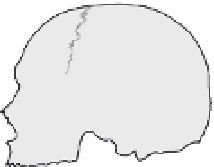Biomedical Engineering Reference
In-Depth Information
(a) (b) (c)
FIGURE 3.32
Bones of the skeletal system are attached to each other at (a) fibrous, (b) cartilaginous, or (c) syno-
vial joints.
The bones of the skeletal system are attached to one another at fibrous, cartilaginous, or
synovial joints (Figure 3.32). The articulating bones of fibrous joints are bound tightly
together by fibrous connective tissue. These joints can be rigid and relatively immovable
to slightly movable. This type of joint includes the suture joints in the skull. Cartilage holds
together the bones in cartilaginous joints. These joints allow limited motion in response to
twisting or compression and include the joints of the vertebral system and the joints that
attach the ribs to the vertebral column and to the sternum. Synovial joints, such as the knee,
are the most complex and varied and have fluid-filled joint cavities, cartilage that covers the
articulating bones, and ligaments that help hold the joints together.
Synovial joints are classified into six types, depending on their structure and the type of
motion they permit. Gliding joints (Figure 3.33) are the simplest type of synovial joint, allow
GLIDING
PIVOT
SADDLE
BALL-AND-
SOCKET
CONDYLOID
HINGE
FIGURE 3.33
Synovial joints have fluid-filled cavities and are the most complex and varied types of joints.
Each synovial joint is classified into one of six types, depending on its structure and type of motion.
















































































































































































































































































































































































































































































































































































































































































































































































































































































































































